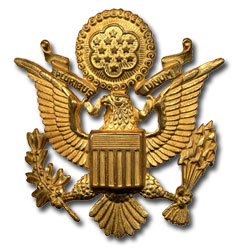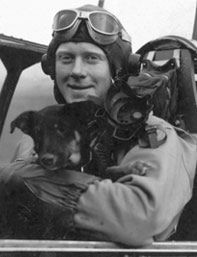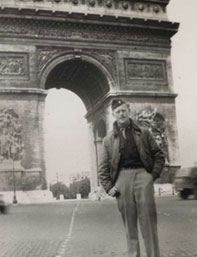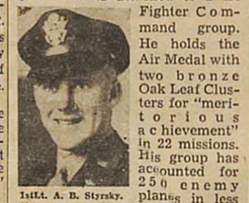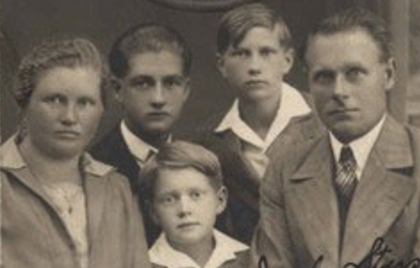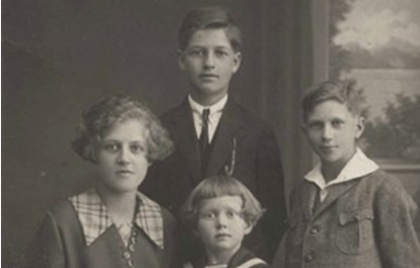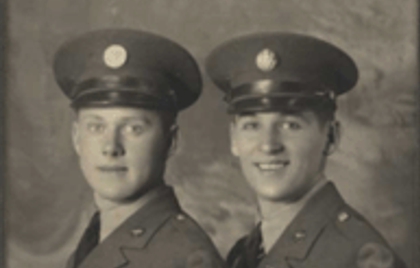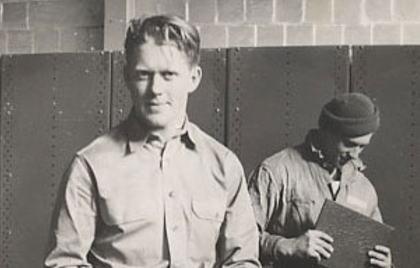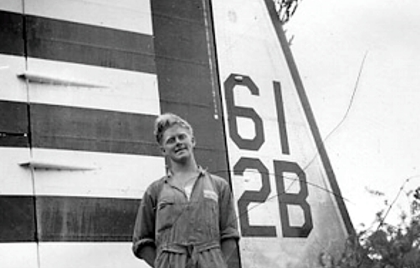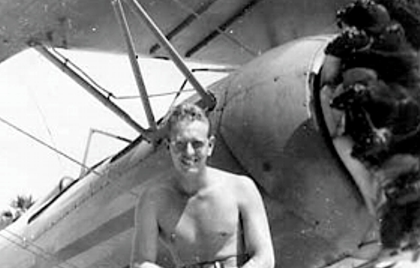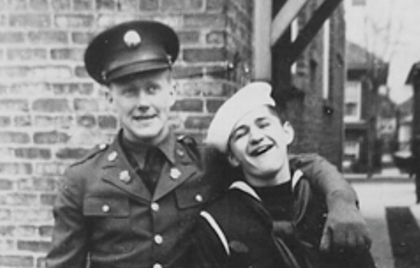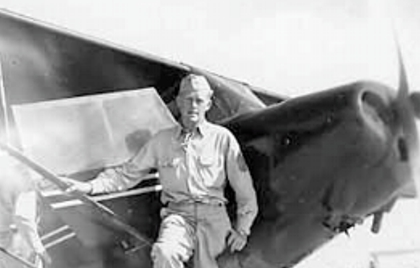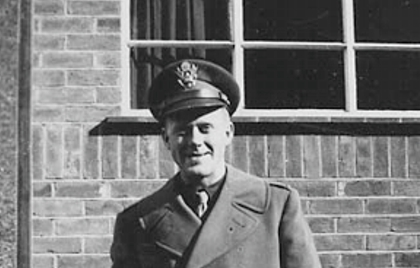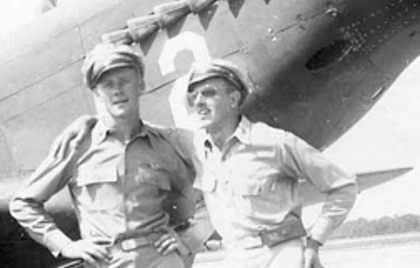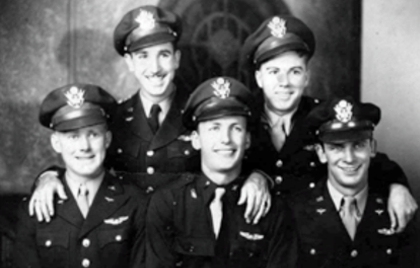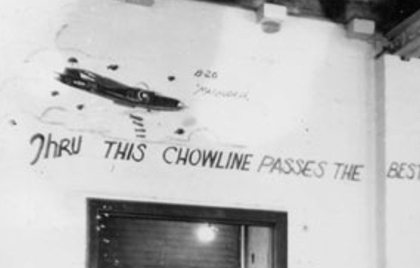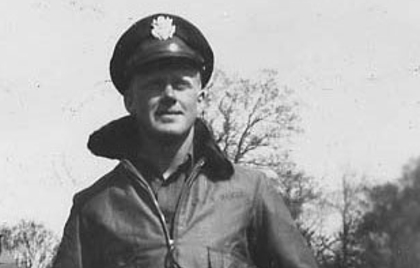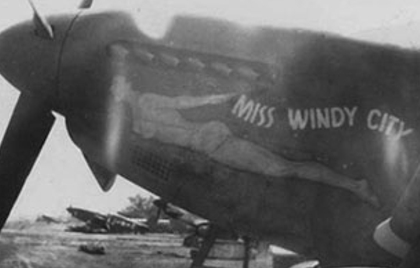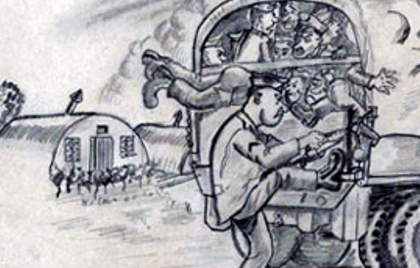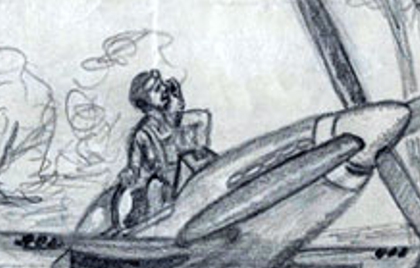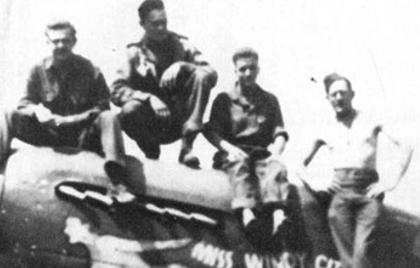Our father was born in 1920 with the name Miroslav Vlastimil Oldřich Štirský in Skuteč, Czechoslovakia. His parents had emigrated to the United States years before his birth and had three sons and one daughter in the states, but they had returned to Europe for several years and dad was born during that time. At the age of 10, the family moved back to the United States due to the increasing tensions in Europe and dad’s name was changed to Alfred Bohumil Styrsky.
Styrsky Family
Dad had a great yearning to fly. It was for this reason that he and his friend Joseph G. Bubenik enlisted with the Army Air Corps. Dad was only 19 years old at the time, and he had to plead with his parents to give their permission for him to join since he was under age. He started out as an airplane mechanic, but as the war drew near he and many of his buddies trained and became pilots.
England: The 354th Fighter Group
Some of dad’s war experience is best described in his own words (excerpt from a letter he wrote):
"In November, 1943, a dozen of my comrades and I arrived in England as pilot replacements to be joined to the well-established 354th Fighter Group based at Boxted. We were most fortunate to be placed in such a well-trained and outstanding group of flyers."
"My first air encounter with the enemy was on my third mission, January 30th, 1944. The flight I had taken off with from Boxted began to disintegrate and when we reached the European coast, three of the flight had aborted and I found myself the only representative. I continued to fly my position in relation to our squadron and when I spotted another lone ranger I joined up with him. It turned out to be Lt. Pate of the 355th Fighter Squadron. After we made a rendezvous with the bombers, Lt. Pate spotted the three ME-110s stalking the bombers about a mile of two to the port side of the bomber formations. After Pate fired at them, he dove into the clouds below. I then engaged them for a time until they broke away and one by one dropped through the cloud deck."
"At this time I found myself entirely alone and I took up a course for England. It was a short time later when a B-17 appeared and closing in on him was a lone ME-110. I drove him away and a short while later a ME-109 began closing in on the B-17 from astern. He also departed upon seeing me closing in on him. While I had not made a kill, I consoled myself in that I had driven off the ME-110s that were probably positioning themselves to lob rockets into the bomber formation."
“In Richard Turner's memoirs (‘Big Friend, Little Friend’), he tells of the mission to dive-bomb a bridge near Rouen, France, June 12. Harry Fisk, whose wing I was on, discovered an airfield with 20 FW-190s and called it out to Richard. While I was following Fisk on our first pass over the field I was discomfited by the many tracers crisscrossing around my plane. I saw where they were coming from, a patch of a wooded area, and I called out to Fisk for us to take that gun position out. I followed Harry on the next pass as he dove on that location and with both of us firing we quelled that problem. This made it much more comfortable for all of us and it became a great sport to hit those sitting ducks. After we reformed we looked back to see 20 FWs burning nicely."
"On another dive-bombing mission on takeoff a 500 lb. bomb dislodged and fell off my right wing, it surprised me to find myself airborne while my leader was still trundling down the runway. After we joined up as a flight I discovered that I had a gaping hole in my right flap. Using the trim tabs I stabilized the flight characteristics of my plane. I continued with the mission and delivered the remaining bomb on our target."
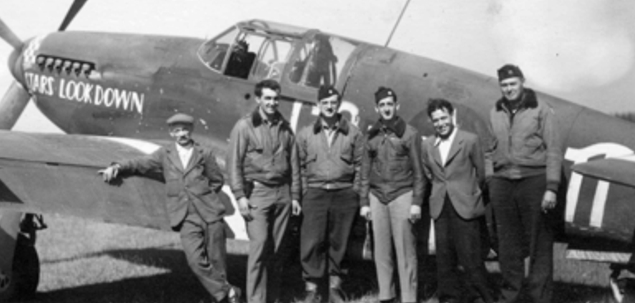
A modified P-51B Mustang piloted by Ninth Fighter Command General Pete Quesada carried the Allied Supreme Commander General Dwight D. Eisenhower on a reconnaissance flight of the Saint-Lo area on 4 July 1944.
"On the 4th of July, the 356th was chosen to escort 'STARS LOOKDOWN,' carrying General Eisenhower and General "Pete" Quesada. While at cruising altitude I felt a hit from ground fire. I knew my plane was hit in the engine area and any moment I expected to see coolant boiling out. Keeping my eye on the gauges I worried for a while. All appeared to be okay and I continued with the mission. No one else experienced any ground fire. Later my crew chief pointed out the marksmanship of the Jerry gunner. He must have had some eye. The hole in the engine cowling was ever so near to a vital coolant line."
"The news account of our harrowing mission on D-Day is enclosed. We escorted slow flying C-47s towing gliders, under a two thousand foot ceiling, during darkness, with no lights in snug formation. Returning fighters from the invasion area added an additional touch of suspense. To further complicate matters my engine began overheating. I found that I was able to keep the temperature normal by using the manual switch although I was taking a chance that there might have been a small coolant leak. It worked out that I was able to complete that mission."
"After the invasion, we were based on A-2 strip in France. One evening we were alerted that, ‘the game was afoot,’ to quote the eminent Sherlock Holmes. We were relaxing at the refreshment bar which was emptied of all flying personnel as we ran to our planes. My loyal crew was replacing a flat tail wheel at the time. I watched from the cockpit as my wing mates sped into the darkening sky. By the time I was airborne I could just see the flicker of exhausts far and away. I did manage to catch the squadron and join up. An extended search for the enemy produced nothing. When we returned to our libations we all agreed that it was a ‘jolly good show’ anyway. “By the end of October I had flown 84 combat missions and was placed on the list for rotation to the United States. This curtailed my combat flying. Being restless, I asked Operations (either Bob Brooks or Harry Fisk) to fly another mission. They were reluctant but finally relented and scheduled me for a dive-bombing mission of a railroad terminal. The cloudy weather hindered our mission severely. A break in the clouds made it possible to bomb the rail yard, but only one plane at a time, limited as we were by visibility restriction."

